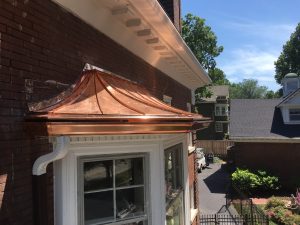Everything You Need to Know About Your Gutter System — In Layman’s Terms
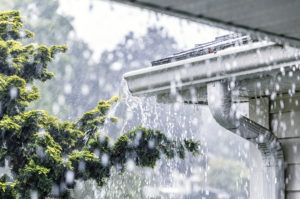
The Need-To-Know About Gutter Systems
Let’s face it – gutters are not exciting…but they are vital to maintain all the things that are exciting with your house: landscaping, exterior paint, and yes, even man caves…all are directly affected by your gutter system.
Gutter systems are not just about protecting the fun stuff, but also the important stuff – like air quality, sheetrock and the very foundation of your home.
They are a key component to keeping your house happy and healthy – inside and out.
So…while gutters might not be the topic of choice at your next soirée, it is important to take a couple of minutes to know just enough to determine if your gutters are doing their job right.
Anything can be interesting if you know the details…right?
Let’s start with the guttering basics:
Does a house really need gutters?
What is included in a guttering system?
What types of gutters are there?
Does it matter what size my gutters are?
What kind of downspout is best?
Then we’ll move to the application:
Why do my gutters overflow?
How to customize a guttering system for your home.
Does A House Really Need A Gutter System?
The short answer: Yes.
The long answer: The role of a guttering system on your home is to carry water safely away from your roof to the ground.
Without a guttering system, all of the water on your roof will fall along the foundation of your home.
This may not seem like that much, but surprisingly, just one inch of rain turns into 1,246 gallons of rainwater on an average sized home!
The foundation of a home simply cannot sustain that amount of water pressure. If left unchecked, basement flooding, and foundation damage will happen.
With foundation damage, you can end up with uneven floors, cracked walls and cracks in the chimney.
That’s just the foundation…
You might notice other problems a little sooner.
Without gutters the paint on the part of the home that meets up with the roof will quickly erode, leaving the wood openly exposed to water. This results in mold and mildew. The siding and trim will begin to look faded, worn or even peel.
As time goes on, water will seep past the exterior soffit and fasian boards toward the insulation of your home. If it persists even longer it could result in water spots on your ceiling or walls.
Key Components to a Gutter System
 Gutter Guards/Covers
Gutter Guards/Covers
These are installed over the top of gutters to keep the gutters free from debris that can block the function of the guttering system. These are especially important if your home has trees surrounding it and/or underground drains.
Gutters
The horizontal channel that attaches to your home and collects the rainwater runoff from your roof.
Gutter Hangers/Brackets
Brackets or spikes that attach the gutters to your home. Most of the time they are hidden. This means they are installed inside the gutter.
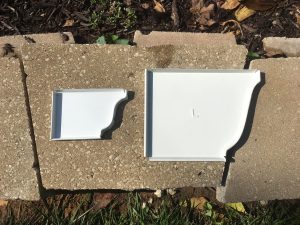
End caps
Found at the far end of a gutter section. End caps close off the open sides of the gutters.
Miters
Connecters that fasten two gutter sections together at a corner.
Downspouts
Vertical channels that carry the water from the gutters to the ground and then away from your home.
 Pipe Cleats
Pipe Cleats
Fasteners that connect the downspout to the side of your home.
Elbows
Curved portion of the downspout. These can be found at both the top and bottom of the downspout. Top elbows connect the gutters to the downspout so the downspout can attach to the side of the house. Bottom elbows direct the water from the downspout away from the house.
Gutter System Components for Improved Function:
Underground Drains
Sometimes called French Drains. These connect to the bottom of the downspout, then carry the water underground and far away from the home. Typically these are used in areas where the ground slopes toward the homes foundation. In such cases, the elbow at the bottom of the downspout simply cannot shoot the water far enough away from the home. In such instances, an underground drain or downspout extension is an excellent option.
Downspout Extension
Additional material added at the end of a downspout to carry water further away from the home. These are used in homes where the ground slopes toward the foundation. These can come in various styles. Some low profile, some decorative, some just get the job done.
Types of Gutters
As with most things, gutter options are based on both form and function. Fortunately, you can find a gutter that has both – so you can have your cake and eat it too!
We will discuss options from both angles, so you can make the best choice for your home.
 Function:
Function:
Gutter Style & Function
Half Round/U-Style
The name applies to the shape. This is simply a half-circle gutter. Carries less water than K-Style, but can work if sized properly. Brackets for this type of gutter sometimes create a space been the gutter and the fascia.
K-Style
Most efficient style for catching rainwater.
Seamed
Gutters that come in pieces and then are sealed at the seams. High maintenance. These must be re-sealed regularly to prevent leakage.
Seamless
Gutter is made to the exact length, customized for the home with no seams except at corners. Low maintenance.
Gutter Materials & Function
Vinyl
$
Seamed and therefore prone to leaks, does not dent, but can bend due to snow or crack in temperature extremes. Relatively short life span (5-10 years in a midwestern climate, 20 years in a moderate, low rain, no snow environment.) In other words, not ideal for Kansas City.
Aluminum
$$
Moderate life span (15-25 years), both seamed and seamless options available, will not rust, can be dented and will eventually corrode.
Steel
$$$
Moderate life span (15-20 years), both seamed and seamless options available, heavier material, must be painted, prone to rust
Copper
$$$$
Long life span (upwards of 60 years), high-quality material, available both with seams and seamless, anti-corrosive. If you choose this option, be aware that your entire gutter system – elbows, downspouts, brackets should all be copper. This is because copper reacts with other metals – copper needs to touch copper.*
* However, if you are in the market for a gutter guard, the Advantage Gutter Guard ® can be retrofitted to match your roof and not react with the copper. Your Gutter Cover KC® professional will explain more. Of course, if you want the Advantage Gutter Guard ® in copper – it is always an option!
Form
Gutter Style & Form
Half Round/U-Style
Traditional style from early 1900s. Ideal for vintage homes.
K-Style
Modern style, developed in 1950s to increase gutter functionality. Side profile looks like the top of a block-styled K, therefore K-Style gutter.
Seamed
Visible seams, tends to have leaks. Tends to rust if made of steel.
Seamless
Continuous material, easy to keep looking clean.
Gutter Materials & Form
Vinyl
Rust-proof, available in brown or white, seamed, prone to leaking and bending.
Aluminum
Seamless, available in nearly any color to complement your home, will not rust, could dent.
Steel
Can be seamed or seamless. Less prone to denting than other materials. Must be painted – so it is most customizable when it comes to color. It is also the highest maintenance since it is prone to rust, and paint chipping/peeling and therefore will need to be repainted throughout its lifetime.
Copper
Can be seamed or seamless, anti-corrosive, unique and very complementary with the right architecture. Will patina quicker in wet climates and slower in dry climates. Like aluminum, copper can be dented. Some HOA’s will not allow it, so check with your HOA before installing.
How to Choose the Right Size Gutter System
Gutter sizes are typically 5 inch and 6 inch – however 8 inch is also available.
The larger the gutter, the more rainwater it can manage before overflowing.
People, therefore, often think – bigger is best – I need 8 inch gutters!
And in certain cases this is true. However, before replacing perfectly good 5 inch gutters, there is a science to help you determine which gutters you really need.
First, you must know how much rain each type of gutter can handle:
K-Style:
5 inch 5,520 sq feet
6 inch 7,960 sq feet
Half Round:
5 inch 2,500 sq feet
6 inch. 3,840 sq feet
Now let’s figure out how much water your gutters need to handle.
How Do You Know What Size Gutters Your Home Needs?
It involves 3 things:
- Roof Pitch Factor – in other words, how steep is your roof? Is your roof more like the plains of Kansas or the mountains of Colorado? The pitch of the roof effects water volume in 2 ways:
-
-
- How quickly water will be rushing off the roof and into your gutters – the difference between a gentle stream and a waterfall.
- How much water is caught by your roof. Wind carrying the rain can force more water onto a steep pitched roof.
-
This Old House has a great explanation on how to determine your roof pitch.
- Roof Surface Area. Determine the surface area of your roof. To do this, Multiply the width of your roof by its height. (Height is determined from the starter row of shingles, to the top of the pitch)
- Rainfall Intensity. In other words, how much rainfall per hour occurs in your region. For those of us in Kansas City, we can expect rainfalls as intense as 7.6 inches per hour. If you’re not in Kansas City, Fine Home Building has a great chart for determining rainfall intensity!
Once you have all three figures – roof pitch, roof surface area and rainfall intensity – multiply these, and you will get how much rainfall your gutter system will be facing.
Roof Pitch Factor X Roof Surface Area X Rainfall Intensity = Max Sq Ft of Rainfall/Hour
This is more math than I’ve done in a while…so I thought I’d throw in an example:
 Imagine you have a beautiful home in Kansas City.
Imagine you have a beautiful home in Kansas City.
You have measured your roof’s pitch and found that it is 6-in-12, so your roof pitch factor is 1.1
You know that the length of your roof is 40 feet and the height is 20 feet. So your roof’s surface area is 600 square feet.
You know the rainfall intensity is 7.6 inches/ hour.
1.1 Roof Pitch Factor X 600 Square Feet X 7.6 in of rainfall = 5,016 square feet of rainfall/hour
Looking at the volume capacity of the different sizes of gutters, a half-round gutter simply could not handle the rainfall load. However, a 5-inch K-Style gutter would work great.
Additional Considerations
It is quite possible that there will be areas of your roof that are steeper than others. Or possibly that the length of gutter they empty into are quite short. In these locations you might need a larger gutter size than the rest of your home. All of this needs to be taken into consideration when replacing your gutter system.
Size of Downspouts
A properly sized gutter only works properly if its connecting downspout can also handle the same load. This is much easier to figure out than the size of gutters. It simply relates directly to the square footage of your roof.
There are two basic types of downspouts – Round and Rectangular:
Round
3 inches = 706 square feet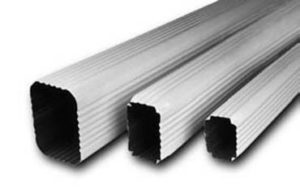
4 inches = 1,255 square feet
Rectangular
2 by 3 inches = 600 square feet
3 by 4 inches = 1,200 square feet
If we return to our previous example, in a home that produced 5,016 square feet of rainfall, he had a 600 square foot section of roof for that 40 foot long gutter. He could get away with two 2 by 3 inch rectangular downspouts on either end of the gutters. However, to be extra safe, 3 by 4 downspouts on either end would easily take care of the water flow.
Now that we’ve discussed the fundamental principles of guttering systems, let’s discuss a common problem with guttering systems.
Why Do My Gutters Overflow?
There are 3 basic reasons for gutters to overflow:
1) Improperly sloped
The gutters should not be perfectly level on your home. This might seem counterintuitive at first glance – we like things to be level. However, gutters must be slightly sloped downward to allow the water to flow towards the downspout. If the water is not given a proper direction to flow, it might just flow right over the top – defeating the gutters entire purpose in the first place.
2) Insufficient volume
As previously discussed, roofs shed a lot of water during a heavy rainfall. If your gutters or downspouts are too small to carry the load, the water has no where to go but over the side of the gutter.
3) Clogged gutters
If debris is taking up space in your gutters – or worse – blocking the water from flowing into the downspout the water will have no option but cascading over the front of those beautifully sized, properly sloped gutters!
A Customized Gutter System for Your Home
Just like us, our homes are unique. It is important to evaluate your home.

1) Figure out how much rainwater your gutter system needs to process.
2) Assess the sizing and sloping of your gutters.
3) Make sure all downspouts are attached, properly sized and there are enough of them to handle the water the gutters deliver to them.
4) Check the integrity of your gutters. Do they leak at the seams? Are there holes? Are they attached to you home properly?
5) Make sure your downspouts are draining water away from your home. If they are emptying on a portion of the ground that slopes toward your foundation you may need a downspout extension or underground/french drains.
6) Clean your gutters regularly. You will be surprised how quickly they fill up with sticky, gooey stuff.

Forget the Ladder…Get a Gutter Guard
If you – like most of us – don’t want to do the math and would prefer not to spend 2 weekends a month cleaning your gutters, get a gutter guard. Not all gutter guards are the same, so do your research.
The Advantage Gutter Guard ® has been proven to work in homes throughout Kansas City. The professionals who come to measure your home will do their own evaluation of your gutter system, identify problem areas, and will make needed changes before installing the Advantage Gutter Guard ®.
Save yourself a headache and ensure your gutter system is in top-notch health by clicking here for a free estimate of The Advantage Gutter Guard ®.

 Gutter Guards/Covers
Gutter Guards/Covers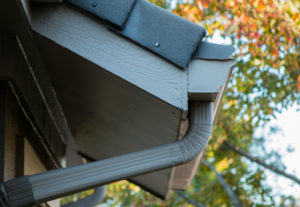 Pipe Cleats
Pipe Cleats Function:
Function: